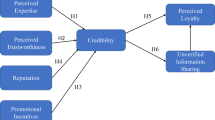Abstract
The purpose of this paper is to explore the concepts of issue legitimacy and organizational legitimacy, providing a new measure of each construct. The scales were developed and tested using data collected through a statewide survey of Alabama residents. Assessments of issue legitimacy were based on perceptions of direct-to-consumer advertising, whereas assessments of organizational legitimacy were based on perceptions of the pharmaceutical industry as a whole. The findings provide evidence that organizational legitimacy can be reliably measured using a five-item scale and issue legitimacy can be reliably measured using a six-item scale. The implications of the results and potential uses of the scales are discussed.
Similar content being viewed by others
References
Aikin, K. J., Swasy, J. L., & Braman, A. C. (2004). Patient and physician attitudes and behaviors associated with DTC promotion of prescription drugs: Summary of FDA survey research results. Washington, DC: U.S. Department of Health and Human Services, Food and Drug Administration.
Ashforth, B. E., & Gibbs, B. W. (1990). The double-edge of organizational legitimation. Organization Science, 1(2), 177–194.
Bortree, D. S. (2009). The impact of green initiatives on environmental legitimacy and admiration of the organization. Public Relations Review, 35, 133–135.
Boyd, J. (2000). Actional legitimation: No crisis necessary. Journal of Public Relations Research, 4, 341–353.
Brummer, J. J. (1991). Corporate responsibility and legitimacy: An interdisciplinary analysis. New York: Greenwood.
Churchill, G. A. (1979). A paradigm for developing better measures of marketing constructs. Journal of Marketing Research, 16, 64–73.
Coombs, W. T. (1992). The failure of the task force on food assistance: A case study of the role of legitimacy in issue management. Journal of Public Relations Research, 4(2), 101–122.
Deephouse, D. L. (1996). Does isomorphism legitimate? Academy of Management Journal, 39(4), 1024–1039.
Deephouse, D. L., & Carter, S. M. (2005). An examination of differences between organizational legitimacy and organizational reputation. Journal of Management Studies, 42(2), 329–350.
DiMaggio, P. J., & Powell, W. W. (1983). The iron cage revisited: Institutional isomorphism and collective rationality in organizational fields. American Sociological Review, 48, 147–160.
Dowling, J., & Pfeffer, J. (1975). Organizational legitimacy: Social values and organizational behavior. Pacific Sociological Review, 18(1), 122–136.
Elsbach, K. D. (1994). Managing organizational legitimacy in the California cattle industry: The construction and effectiveness of verbal accounts. Administrative Science Quarterly, 39, 57–88.
Elsbach, K. D., & Sutton, R. I. (1992). Acquiring organizational legitimacy through illegitimate actions: A marriage of institutional and impression management theories. Academy of Management Journal, 35(4), 699–738.
Etzioni, A. (1987). Entrepreneurship, adaptation and legitimation: A macro-behavioral perspective. Journal of Economic Behavior & Organization, 8, 175–189.
Hair, J. F., Anderson, R. E., Tatham, R. L., & Black, W. C. (1998). Multivariate data analysis (5th ed.). Upper Saddle River, NJ: Prentice Hall.
Hearit, K. M. (1995). Mistakes were made: Organizationa, apologia, and crises of social legitimacy. Communication Studies, 46(1), 1–17.
Hegtvedt, K. (2004). Legitimizing legitimacy: Shaping a new frontier of research. Social Justice Research, 17(1), 93–109.
Joreskog, K. G. (1969). A general approach to confirmatory maximum likelihood factor analysis. Psychometrika, 34, 183–202.
Kostova, T., & Zaheer, S. (1999). Organizational legitimacy under conditions of complexity: The case of the multinational enterprise. Academy of Management Review, 24(1), 64–81.
Marsh, H. W., Balla, J. R., & Hau, K. T. (1996). An evaluation of incremental fit indices: A clarification of mathematical and empirical processes. In G. A. Marcoulides & R. E. Schumacker (Eds.), Advanced structural equation modeling techniques (pp. 315–353). Hillsdale, NJ: Erlbaum.
Massey, J. E. (2001). Managing organizational legitimacy: Communication strategies for organization in crisis. The Journal of Business Communication, 38(2), 153–183.
Meyer, J., & Rowan, B. (1977). Institutionalized organization: Formal structure as myth and ceremony. American Journal of Sociology, 83, 340–363.
Meyer, J. W., & Scott, R. (1983). Organizational environments: Ritual and rationality. Beverly Hills, CA: Sage.
Oliver, C. (1991). Strategic responses to institutional processes. Academy of Management Review, 16(1), 145–179.
Parsons, T. (1963). On the concept of influence. Public Opinion Quarterly, 27, 63–82.
Pfeffer, J., & Salancik, G. R. (1978). Organizational decision making as a political process: The case of a university budget. Administrative Science Quarterly, 19, 135–151.
Ruef, M., & Scott, M. (1998). A multidimensional model of organizational legitimacy: Hospital survival in changing institutional environments. Administrative Science Quarterly, 43, 877–904.
Scott, W. A. (1995). Reliability of content analysis: The case of nominal scale coding. The Public Opinion Quarterly, 19(3), 321–325.
Sethi, S. P. (1977). Advocacy advertising and large corporations: Social conflict, big business image, the news media, and public policy. Lexington, MA: D. C. Heath.
Shoemaker, P. J. (1982). The perceived legitimacy of deviant political groups: Two experiments on media effects. Communication Research, 9(2), 249–286.
Spector, P. E. (1992). Summated rating scale construction: An introduction. Newbury Park, CA: Sage.
Suchman, M. C. (1995). Managing legitimacy: Strategic and institutional approaches. Academy of Management Review, 20(3), 571–610.
Tornikoski, E. T., & Newbert, S. L. (2007). Exploring the determinants of organizational emergence: A legitimacy perspective. Journal of Business Venturing, 22, 311–335.
Zimmerman, M. A., & Zeitz, G. J. (2002). Beyond survival: Achieving new venture growth by building legitimacy. Academy of Management Review, 27(3), 414–431.
Author information
Authors and Affiliations
Corresponding author
Rights and permissions
About this article
Cite this article
Chung, J.Y., Berger, B.K. & DeCoster, J. Developing Measurement Scales of Organizational and Issue Legitimacy: A Case of Direct-to-Consumer Advertising in the Pharmaceutical Industry. J Bus Ethics 137, 405–413 (2016). https://doi.org/10.1007/s10551-014-2498-8
Received:
Accepted:
Published:
Issue Date:
DOI: https://doi.org/10.1007/s10551-014-2498-8




